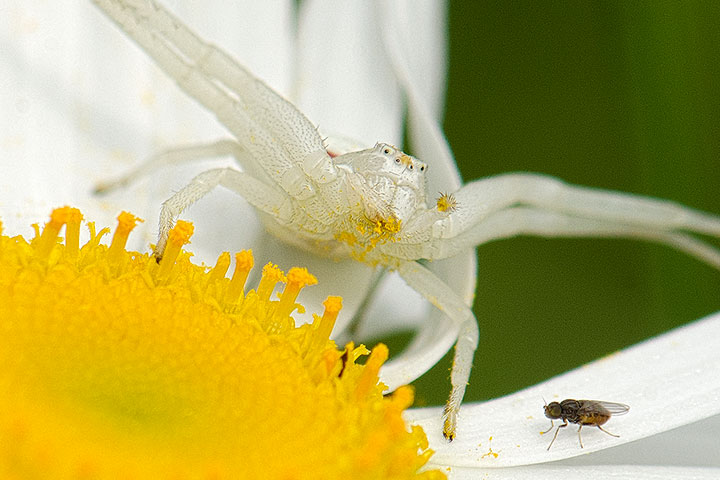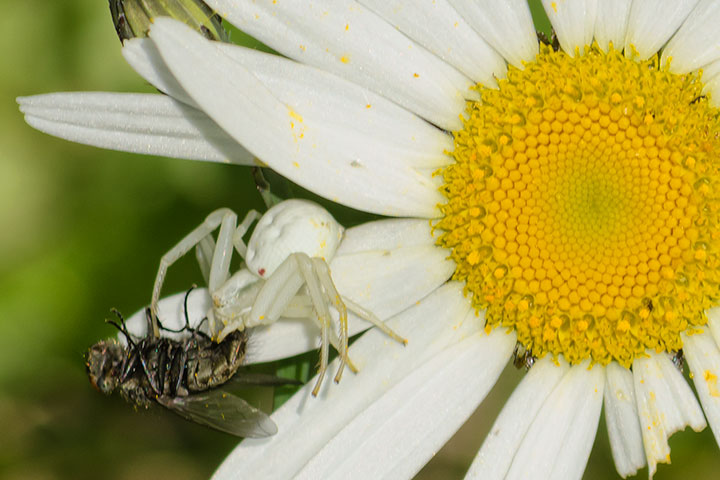The crab spider (Misumena vatia) lives by deception. On a yellow flower, it turns yellow; on a white flower, it turns white. In this way, it is camouflaged as it awaits pollinators.
So, how will it present itself when on a daisy? This is a compound flower made up of yellow disk flowers and white ray flowers? Can the spider be both white and yellow at the same time? It seems the answer is that it always makes itself white and sits on the ray flowers (the parts that looks like petals). Yet, as these pictures suggest, it completes its disguise by dabbing itself with some of the yellow pollen.
This crab spider is sitting on the white ray flowers, but seems to have used its pedipalps to dab some yellow pollen on itself so as to entice a pollinator. That is really a nice trick.

This is the same daisy and same spider but it has now caught a fly. Its dual deception pays.


Following is an amalgam of an article from Science News (http://www.wired.com/wiredscience/2009/11/spider-color-changing-mystery/) and Wikipedia.
Long touted as an example of cryptic coloring, the female Misumena vatiaspider (the Krab spider as we would call it) switches her body color over the course of days depending on the flower where she lurks. Contrary to the textbook scenario, though, a white spider on a white flower doesn’t catch more prey than a white spider moved to a yellow flower, researchers report online November 3 in Proceedings of the Royal Society
Nor does a yellow spider on a yellow flower get a color-coordination bonus, says study coauthor Rolf Brechbühl of the University of Fribourg in Switzerland. He and his colleagues reached this conclusion after videotaping some 2,000 occasions when an insect buzzed over to a flower that held a spider. Sitting on a bloom ready to pounce on pollinators, the spider supposedly shifts to match her background by switching between white and yellow. To human eyes, she looks as if she’s becoming harder for her prey to see.
The study “finally shatters the myth of crypsis by color matching in crab spiders,” comments behavioral ecologist Marie Herberstein of Macquarie University in Sydney, who was not part of the study. “I suspect that textbooks may now need to be rewritten.”
Color changing probably has some adaptive benefit for the spiders, according to ecologist Thomas C. Ings of Queen Mary University of London. What those benefits might be still isn’t clear, he says, “but this paper is exciting, as it shows that we may be focusing our attention in the wrong direction.”
Another possible direction — protection from the spider’s own predators — also doesn’t look encouraging in the new study. Brechbühl says that his research focused on spider prey, but he points out that all this videotaping took place in a field with plenty of birds and other possible menaces around. Even though he frequently moved spiders to flowers of the wrong color, he recorded only one predator (a bird) nabbing a spider.
Ideas about crab spider coloration have been unraveling since 2001 when Lars Chittka, also of Queen Mary, pointed out that bees see ultraviolet wavelengths but that non–UV-reflecting spiders often sit on UV-reflecting flowers.
To test for an effect of color on M. vatia crab spiders’ hunting, Brechbühl and his colleagues set up clusters of yellow, white and violet wildflowers in a field. The researchers filmed each spider for three days, tallying all potential prey. Spiders caught only 3.5 percent of insect visitors, and in terms of volume of insect meat, color-coordination didn’t make a difference to the catch.
Musing about other possible benefits of color changing, Ings notes that only adult females change color. “So is there a specific advantage to crypsis in mature females about to lay eggs?” he says. Or perhaps the color change worked against other predators or prey in the past and has not been lost.
Now as to how the colour change is effected, unlike cuttle fish which have chromatophores which can become virtually any colour, the krab spider s change color by secreting a liquid yellow pigment into the outer cell layer of the body. On a white base, this pigment is transported into lower layers, so that inner glands, filled with white guanine, become visible. If the spider dwells longer on a white plant, the yellow pigment is often excreted. It will then take the spider much longer to change to yellow, because it will have to produce the yellow pigment first. The color change is induced by visual feedback; spiders with painted eyes were found to have lost this ability.
The color change from white to yellow takes between 10 and 25 days, the reverse about six days.
Dave, first I am pleased to meet someone else who reads Science News. I missed that article—nice. So, it is unclear just what this crab spider is doing. We may not have properly assessed its tactics—the plot unfolds. However, we may have probably properly assessed the efficacy of them. Thank you for these insights. I will watch it with even greater interest now.
Alistair: I’ve been away and computerless most of the summer and am just moving through a number of your sendings. This makes me even more endeared to the spider. Your last photo captures the logarithmic spirals of the daisy beautifully.